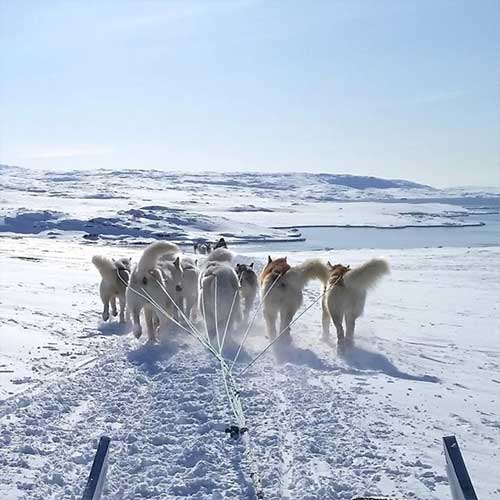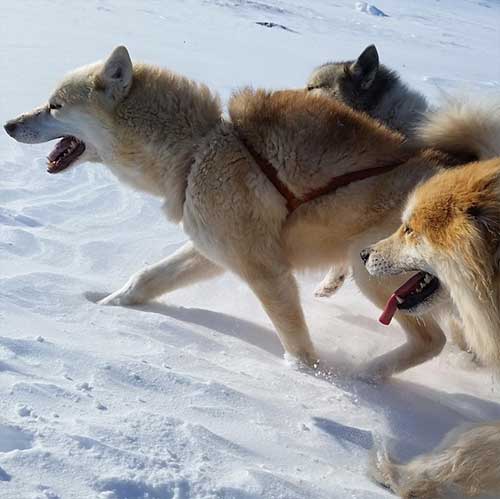
Unique sled dogs helped the inuit thrive in the North American ArcticNovember 29, 2019
The latest research is the result of nearly a decade's work by University of California, Davis, researchers in anthropology and veterinary genetics, who analyzed the DNA of hundreds of dogs' ancient skeletal remains to determine that the Inuit dog had significantly different DNA than other Arctic dogs, including malamutes and huskies. Dr Carly Ameen, an archaeologist from the University of Exeter who led the study, said: "Dogs have lived in North America for as long as humans, but we show here that the Inuit brought new dogs to the region which were genetically distinct and physically different from earlier dogs.
Experts had thought the Inuit used dogs to pull sledges, and this is the first study which shows they introduced a new dog population to the region to do this. These dogs then spread across the North American Arctic alongside Inuit migrants. "Thousands of years ago there was not the huge number of dog breeds as we know them today. Through analysing the DNA and morphology of the remains of hundreds of dogs we've found that the dogs used by the Inuit had distinctive skull and teeth shapes, and would have likely looked different in life to dogs already in the Arctic." The article, "Specialized sledge dogs accompanied the Inuit dispersal across the North American Arctic," was published Wednesday in the Proceedings of the Royal Society B: Biological Sciences. From UC Davis, authors include Christyann Darwent, professor of anthropology; Ben Sacks, adjunct professor and director of the Mammalian Ecology and Conservation Unit, Veterinary Genetics Laboratory, School of Veterinary Medicine; and Sarah Brown, a postdoctoral researcher. Lead author Carly Ameen is an archaeologist from the University of Exeter; Tatiana Feuerborn is with the Globe Institute in Denmark and Centre for Palaeogenetics in Sweden; and Allowen Evin is at the CNRS, Université de Montpellier, Institut des Sciences de l'Evolution in Montpellier, France. The list of authors includes many others from a large number of collaborating institutions. Qimmiit (dogs in Inuktitut) were viewed by the Inuit as particularly well-suited to long-distance hauling of people and their goods across the Arctic and consuming local resources, such as sea mammals, for food. The unique group of dogs helped the Inuit conquer the tough terrain of the North American Arctic 2,000 years ago, researchers said. Inuit dogs are the direct ancestors of modern Arctic sled dogs, and although their appearance has continued to change over time, they continue to play an important role in Arctic communities.
According to Sacks "the genetic profiles of ancient dogs of the American Arctic dating to 2,000 years ago were nearly identical to those of older dogs from Siberia, but contrasted starkly with those of more ancient dogs in the Americas, providing an unusually clear and definitive picture of the canine replacement event that coincided with the expansion of Thule peoples across the American Arctic two millennia ago." Experts examined the DNA from 921 dogs and wolves who lived during the last 4,500 years. Analysis of the DNA, and the locations and time periods in which they were recovered archaeologically, shows dogs from Inuit sites occupied beginning around 2,000 years ago were genetically different from dogs already in the region. Preserving an important history Research confirms that native peoples maintained their own dogs. By analyzing the shape of elements from 391 dogs, the study also shows that the Inuit had larger dogs with a proportionally narrower cranium to earlier dogs belonging to pre-Inuit groups. The National Science Foundation-funded portion of the research at UC Davis was inspired by Inuit activist and author Sheila Watt-Cloutier, who told Darwent about Inuit sled-dog culling undertaken by Canadian police in the 1950s and asked if there was a way to use scientific methods to tell the history and importance of sled dogs in the Arctic. Preservation of these distinctive Inuit dogs is likely a reflection of the highly specialized role that dogs played in both long-range transportation and daily subsistence practices in Inuit society.
Source of News:
|
|||||

